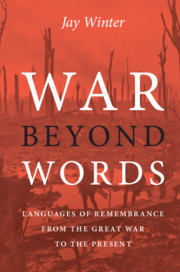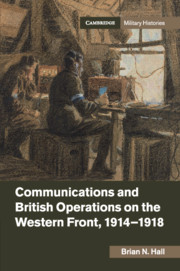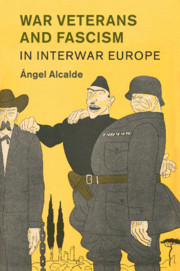Refine search
Actions for selected content:
15418 results in Military history

War beyond Words
- Languages of Remembrance from the Great War to the Present
-
- Published online:
- 04 July 2017
- Print publication:
- 06 July 2017

Communications and British Operations on the Western Front, 1914–1918
-
- Published online:
- 04 July 2017
- Print publication:
- 07 June 2017

The Forgotten Front
- Patron-Client Relationships in Counterinsurgency
-
- Published online:
- 04 July 2017
- Print publication:
- 09 June 2017

Soldiers of Empire
- Indian and British Armies in World War II
-
- Published online:
- 29 June 2017
- Print publication:
- 27 May 2017

War Veterans and Fascism in Interwar Europe
-
- Published online:
- 29 June 2017
- Print publication:
- 07 June 2017
2 - Losing an Empire, Re-Entering the Stage
- from Part I - A World in Upheaval
-
-
- Book:
- Decades of Reconstruction
- Published online:
- 04 July 2017
- Print publication:
- 13 June 2017, pp 50-67
-
- Chapter
- Export citation
13 - Violent Reconstruction as Shatterzones
- from Part IV - Central Europe and Its Borderlands in the Twentieth Century
-
-
- Book:
- Decades of Reconstruction
- Published online:
- 04 July 2017
- Print publication:
- 13 June 2017, pp 256-272
-
- Chapter
- Export citation
3 - How Long Was the Seven Years’ War?
- from Part I - A World in Upheaval
-
-
- Book:
- Decades of Reconstruction
- Published online:
- 04 July 2017
- Print publication:
- 13 June 2017, pp 68-84
-
- Chapter
- Export citation
15 - Reassessing the League of Nations’ Humanitarian Assistance Regimes, 1918–1939
- from Part V - A New International Order After Total War?
-
-
- Book:
- Decades of Reconstruction
- Published online:
- 04 July 2017
- Print publication:
- 13 June 2017, pp 293-314
-
- Chapter
- Export citation
9 - US Reconstruction, Republicanism, and Imperial Rivalries in the Caribbean after 1865
- from Part III - Civil and Uncivil Wars
-
-
- Book:
- Decades of Reconstruction
- Published online:
- 04 July 2017
- Print publication:
- 13 June 2017, pp 179-197
-
- Chapter
- Export citation
Part III - Civil and Uncivil Wars
-
- Book:
- Decades of Reconstruction
- Published online:
- 04 July 2017
- Print publication:
- 13 June 2017, pp 177-236
-
- Chapter
- Export citation
Part II - Between Reich and State
-
- Book:
- Decades of Reconstruction
- Published online:
- 04 July 2017
- Print publication:
- 13 June 2017, pp 103-176
-
- Chapter
- Export citation
4 - The Reorganization of Europe in 1815 as a “Subject of Domestic Policy”
- from Part I - A World in Upheaval
-
-
- Book:
- Decades of Reconstruction
- Published online:
- 04 July 2017
- Print publication:
- 13 June 2017, pp 85-102
-
- Chapter
- Export citation
Acknowledgments
-
- Book:
- Decades of Reconstruction
- Published online:
- 04 July 2017
- Print publication:
- 13 June 2017, pp xv-xvi
-
- Chapter
- Export citation
5 - The Habsburg Empire after 1763 and 1815
- from Part II - Between Reich and State
-
-
- Book:
- Decades of Reconstruction
- Published online:
- 04 July 2017
- Print publication:
- 13 June 2017, pp 105-122
-
- Chapter
- Export citation
1 - Sea Power and Informal Empire
- from Part I - A World in Upheaval
-
-
- Book:
- Decades of Reconstruction
- Published online:
- 04 July 2017
- Print publication:
- 13 June 2017, pp 31-49
-
- Chapter
- Export citation
Notes on Contributors
-
- Book:
- Decades of Reconstruction
- Published online:
- 04 July 2017
- Print publication:
- 13 June 2017, pp viii-xiv
-
- Chapter
- Export citation
Part VI - Prospects
-
- Book:
- Decades of Reconstruction
- Published online:
- 04 July 2017
- Print publication:
- 13 June 2017, pp 347-364
-
- Chapter
- Export citation
10 - After the “German Civil War” of 1866
- from Part III - Civil and Uncivil Wars
-
-
- Book:
- Decades of Reconstruction
- Published online:
- 04 July 2017
- Print publication:
- 13 June 2017, pp 198-215
-
- Chapter
- Export citation
Copyright page
-
- Book:
- Decades of Reconstruction
- Published online:
- 04 July 2017
- Print publication:
- 13 June 2017, pp iv-iv
-
- Chapter
- Export citation
